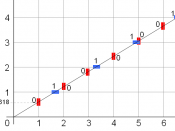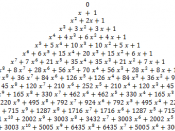The Fibonacci numbers are 0, 1, 1, 2, 3, 5, 8, 13, 21, 34, 55, 89, 144, 233, 377, 610, 987, 1597, 2584, 4181, 6765, 10946,, ... (add the last two to get the next)
Leonardo of Pisa , also known as Fibonacci, to describe the idealized growth of a rabbit population used this theory, assuming:
In the 1st month, there is one newly-born pair.
New-born pairs are fertile from their second month onwards.
Each month every fertile pair produces a new pair, and
The Rabbits do not die.
There are many incredibly complicated formulae for calculating the Fibonacci numbers. The numbers have been worked out into the millions of digits.
Many examples of the Fibonacci Numbers can be found everywhere in nature. Snail Shells follow a spiral following this kind of pattern:
The seeds in a sunflower plant also follow this pattern. The numbers relate to the golden section, which govern many rules of maths and science.
Golden Ratio:
;The golden ratio (also known as the divine proportion, golden mean or golden section) is an irrational number, approximately 1.61803399.
It is common in the ratios of distances in simple geometric figures such as the pentagram, decagon and dodecagon.
It is represented by the symbol phi, not to be confused with Pi
It has amazed everyone that such amazing coincidences can occur naturally in nature, as the ratio between two distances in many plants and shells. People have said that this was programmed into nature by God, therefore proving his existence.


